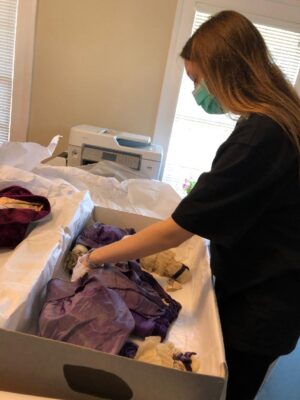Preserving history comes in many forms. You might keep photo albums (remember those?), create scrapbooks, save letters and journals, or collect ephemera and heirlooms that help tell the story of you and your family. What is the best way to safeguard these treasures for the future? Small objects like photographs or letters can be easy to preserve with the proper archival storage materials and a cool, dark environment, but what about antique garments?

Mendocino High School intern Mercedez Jones layers tissue paper around an antique garment in an archival box at the Kelley House Museum. This is the bodice of a day gown, made from purple silk taffeta, velvet, and ivory organdy with crocheted lace. It belonged to Abigail Kelley Blair, William Kelley’s sister, who lived in a elaborate house on Van Ness Avenue in San Francisco with her wealthy husband, Captain Samuel Blair and her two children Will and Jennie.
The Kelley House Museum is fortunate to have some spectacular garments in our collection. From elaborately embroidered ball gowns worn in front of kings, to simple day dresses, uniforms, and a charming collection of Daisy’s MacCallum’s hats, we steward a wide range of clothes made out of every kind of material. Perhaps you have a special dress or jacket that belonged to an ancestor and wonder how best to store it for the next generation?
The first step involves carefully assessing the garment and noticing where there are issues. Are there stains, loose threads, missing buttons, tears, or signs of insects? Look over your garment very carefully and try to determine what kind of shape it is in. If you see any sign of moths or other insect activity, DO NOT WASH IT!! The best way to stop an insect infestation in a garment is to freeze it. Carefully wrap the garment in a sealed plastic bag, then freeze for 72 hours to a week; this will destroy any larvae. Thaw carefully without moving it much, then remove the garments from the bag.
If you see staining or discoloration, the temptation will be very great to wash the garment – don’t do it. Antique fabrics cannot handle the modern washing machine on any setting. Modern soaps are also a problem. Even if you attempt the gentlest hand washing, the fabrics themselves may dissolve or fracture. The stains, tears, and damage you see also tell part of the object’s history. Maybe you can collect information about how a button was lost, or a hem was torn and, therefore, enhance your garment’s story for future generations.
Once you have inspected your garment, dealt with any pests, and talked yourself out of trying to launder it, then it is ready to be stored. You will need archival (acid-free) tissue paper and an archival (acid-free) box. Archival material will keep your garment safe for years to come without causing staining.
When deciding on box size, think large. Ideally, you don’t want to fold the garment, or if you must, only fold it in half. Stacking garments in a box will crush fibers and make permanent creases over time, so you will need multiple boxes if you have several garments.
Before you get started, decide where the boxes will be stored. Cold is better than hot, and dry is a must. The hot attic is better than the cool but damp basement. Garages are tricky because of temperature fluctuations and exhaust. A pantry shelf or on the top of a cool dark closet is the best choice. Use boxes that will fit in your storage area.
The final steps are straightforward. With clean hands, gently spread the garment out on a clean, flat surface. Make loose tissue paper balls and lightly fill the sleeves, bodice, or any other enclosed section of the garment. If there is a large skirt you may want to roll the two sides together gently and stuff tissue paper inside the rolls. Everything should be done loosely – don’t cram or stuff. This gentle filling will help prevent the fibers from collapsing over time. Leave fasteners and buttons undone, as this place less pressure on the threads.
Layer tissue paper in the base and set the garment in the box. If you must fold it, do it gently and bolster the fold with a bit of tissue paper. Arrange the garment to be as close to its natural size – not crimped or cramped – as possible, this allows the fabric to breathe and the fibers to relax.
Next, layer tissue paper over the garment and place the lid on top. Archival box lids tend to fit snugly, so you don’t need to seal the boxes. A final recommendation is to type up a description and any history you have on the garment, place it in a sealed Ziplock bag, and tape it to the outside of the box. Your carefully preserved garment will be admired and appreciated for years to come!
If you would like to learn more about the garments the Kelley House Museum has in its collection, contact curator@kelleyhousemuseum.org or browse the collections at our website www.kelleyhousemuseum.org. And if you would like to help support the Kelley House in our mission to preserve history, please consider becoming a member. Our website makes it easy!